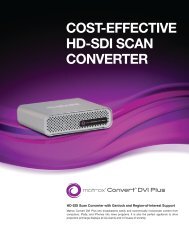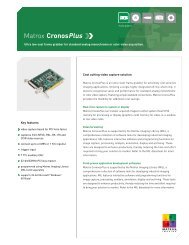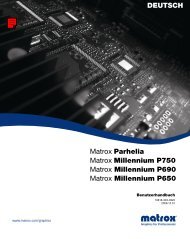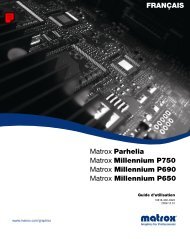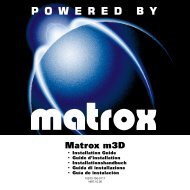Rapid prototyping with Matrox Inspector 4.0
Rapid prototyping with Matrox Inspector 4.0
Rapid prototyping with Matrox Inspector 4.0
Create successful ePaper yourself
Turn your PDF publications into a flip-book with our unique Google optimized e-Paper software.
TECH TALK<br />
6<br />
WITH PIERANTONIO BORIERO,<br />
PRODUCT LINE MANAGER FOR MATROX IMAGING<br />
3.3 Volt/64-bit PCI/PCI-X Slot<br />
3.3 Volt key<br />
5 Volt/64-bit PCI Slot<br />
32-bit 64-bit<br />
extension<br />
5 Volt key<br />
32-bit 64-bit<br />
extension<br />
Universal 64-bit Card Edge Connector<br />
3.3 Volt key slot 5 Volt key slot<br />
32-bit 64-bit<br />
extension<br />
No more<br />
bottlenecks<br />
<strong>with</strong> PCI-X<br />
PCI-X is a high-performance enhancement to the conventional PCI bus<br />
specification. This technology, <strong>with</strong> its increased performance, addresses<br />
the demanding I/O requirements for a new generation of high-bandwidth<br />
applications like Gigabit Ethernet and high-speed CameraLink cameras.<br />
Version 1.0 of PCI-X specifies a 64-bit connection running at speeds of 66,<br />
100 or 133 MHz, resulting in a peak bandwidth of 528, 800 or 1064<br />
Megabytes per second, respectively.<br />
Equally important, PCI-X provides backward compatibility by allowing devices<br />
to operate at conventional PCI frequencies and modes when installed in such<br />
systems. PCI-X peripheral cards can operate in a conventional PCI slot,<br />
although only at PCI rates and may require a 3.3 V conventional PCI slot.<br />
Similarly, a PCI peripheral card <strong>with</strong> a 3.3 V or universal card edge connector<br />
can operate in a PCI-X slot, however the bus clock will remain at a frequency<br />
acceptable to the PCI card.<br />
However, as <strong>with</strong> many technologies, there is a trade-off. In the case of PCI-X,<br />
speed is sacrificed as the number of slots per bus segment increases. A bus<br />
segment is loosely defined as the number of slots emanating from or<br />
between bridges. A 66 MHz operation allows a maximum of four slots per bus<br />
segment (compared <strong>with</strong> a maximum of two slots for 66 MHz conventional<br />
PCI). A 100 MHz operation allows a maximum two slots per bus segment,<br />
while a 133 MHz operation allows a maximum of one slot per bus segment.<br />
Server and workstation class systems and motherboards are starting to<br />
make their appearance <strong>with</strong> PCI-X equipped core logic chipsets such as<br />
the ServerWorks Grand Champion series, Intel® E7500 and the soon-toarrive<br />
AMD-8000 Series. The ePCI-X specification from the PCI Industrial<br />
Computer Manufacturers Group (PICMG) will pave the way for industrial<br />
PCs <strong>with</strong> PCI-X slots.<br />
PCI-X doesn’t stop at Version 1.0. Version 2.0 is currently being drafted by the<br />
PCI Special Interest Group (PCISIG) – the organization that created and now<br />
maintains PCI-X and conventional PCI – and this version promises to double<br />
and quadruple the current bandwidth allowances.<br />
And stay tuned as <strong>Matrox</strong> Imaging will soon be announcing an exciting new<br />
generation of frame grabbers and vision processors that take advantage of<br />
PCI-X technology!



